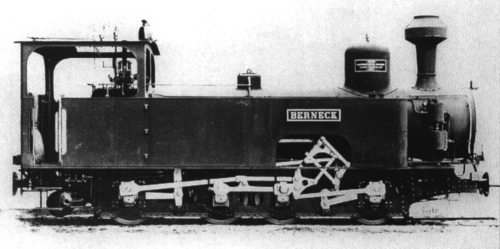|
| Klose To The Edge: The Klose Articulated Locomotives.
|
|
Gallery opened Jan 2003
Updated: 20 Oct 2022
(Previous update 24 Oct 2003)
Link to video added
Information on length of service & other matters kindly provided by Fritz Gallwitz
 
| | |
The Klose System was one of many designed to allow the coupled wheels of a locomotive to swivel as it followed tight bends. This means that the connecting rods have to change in effective length while still driving the wheels, but saves having to make the steam-tight swiveling joints needed for a conventional articulated locomotive. The system was called in German either Klose Lenkachsen (Klose steering axles) or Klose Triebwerk. (The Klose Engine) It was only applied to narrow-gauge locomotives.
All the locomotives on this page were given BR ( = Bauartreihe = design series) numbers after the unification of the German railway systems in 1920 - 25, following the unification of the German kingdoms in 1871. See Railway History in Germany for more details.
From my correspondent Nils Moh:
"Krauss first delivered Locomotives to Bosnia, later to become JZ class 189. Shortly later Krauss delivered 2 very similar Locomotives to Saxony and Hartmann built 4 more. The saxon locomotives are nowadys known as "III K", nobody uses the DRG numbers, because they were scrapped before the new numbering was even applied."
 |
| BR99 754
Left: Klose 0-6-2 loco of the Saxony State Railways. (750 mm gauge) Built by the Chemnitz works in 1889. Six were built.
In this locomotive only the central axle is fixed to the frame; those on either side swivel to accomodate track curvature. This is articulation taken to the limit, and could presumably handle even tighter curves than more conventional (?) approaches like Meyer articulation.
|
 |
| BR99 754
Left: Side elevation of the Klose 0-6-2 BR99 754.
This class was in use until 1926
|
 |
| Left: The Klose linkage system.
The green parts are rigid components. The drive from cylinder to the central axle is not shown, nor is the valvegear.
Assume that the loco is going round a curve so the wheels move together as shown by the big blue arrows. The levers A,A transfer this to the bellcrank B which alters the angle of the lozenge linkage and so alters the effective length of the connecting rods. The overall effect is something like that of a car differential.
All clear? It could hardly be simpler!
|
 |
| BR99 62
A bit more Klose Lenkachsen. This 750mm (29.5") gauge 0-8-0 was built for the Württemberg railway in 1894
Boiler pressure: 12 bar
The class was in use until 1928
|
 |
| Left: 191-001, a Klose 0-10-2 locomotive
It was built in 1893 for the BHStB. (Bosnien-Herzogowinische StaatsBahn)
|
The first Klose locomotives were used on the 2' 6" lines of Bosnia. Others were later used in Saxony, Würtemberg and Switzerland. The first locomotive was delivered in 1891, and an improved version was tried out in 1910.
One of the Klose locos for the Württemberg Railway was a three-cylinder design (one inside, two outside) which could be worked either simple or compound. In compound use the inside cylinder was the HP and the outside ones LP.
Adolf Klose was Engineer of the Chemin de Fer de l'Union Suisse and later Manager of the Württemberg Railways.
 |
| BR99 17
BR99 17: a Klose 0-4+4-0 locomotive. Built 1891 for the Württemberg StaatsBahn metre gauge.
Three were built, and the class lasted until 1931.
|
 |
| BR99 17
Left: Side elevation of BR99 17 "Berneck".
|
 |
| BR99 50
BR99 50: a Klose 0-6-0 locomotive. Built 1896 for the Württemberg StaatsBahn 750 mm gauge. Four were built.
Note that here the cylinders appear to be driving the top of the link system.
The class was in use until 1927
|
 |
| BR99 17
Left: Side elevation of BR99 50
|
VIDEO OF KLOSE LOKOMOTIVE
 |
| Left: A Klose Lokomotive working in Yugoslavia: August 1965
The location is Sarajevo, on narrow gauge. This machine is Kloselok JZ189-013; it does not match exactly any of the locomotives pictured above.
There exists a rare video of it working, with the Klose mechanism heaving up and down. See here for the YouTube video.
Many thanks to Nils Moh for bringing this to my attention.
|
I have no information on the performance of these remarkable locomotives, but since several were made the principle appears to have been sound. There would have been more maintenance of the complicated lever-work, but this looks like it would have been manageable.
The Klose system was one of the more successful, but by no means the only method developed for driving swivelling axles. Another successful system was:
The Hagans Oscillating-Lever System. (Prussian State Railway, Tasmania, Greece)
This system appeared in 1894 and was much used in Germany; in 1905 there were 152 Hagans locomotives in use on the Prussian and Hessian State Railways. However, they disappeared as fast as they appeared, so there must have been problems. Only one was sent to Tasmania but it did sterling service there, until eventually replaced by the first ever Garretts.
Other locomotive drive system delights were:
The Fink countershaft system. (Austrian State Railways)
This was applied to three locomotives in the period 1862-67 but was Kinematically Incorrect and "did not give satisfaction." That phrase again.
The Klien-Lindner Ball & Socket System. (Germany, Austria, Sardinia, Java)
Invented about 1890 by Klien of Dresden. Widely used on narrow-gauge lines, but also appeared in standard gauge.
Luttermöller. This was used in Java.
I have restricted the list above to those which saw some serious use; other lever-type systems were proposed by Maffei, Thouvenot, Weidknecht, Roy, Rarchaert, Dredge & Stein, Gouin, Larpent... and so on.
Bibliography: "Articulated Locomotives" by Lionel Wiener.
















